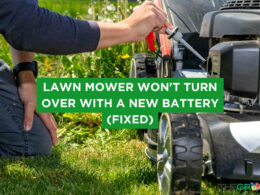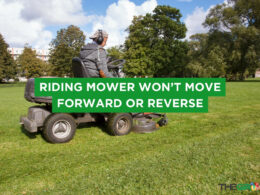In This Article Show
A riding mower not moving when in neutral is quite a common issue and in most cases, it is due to a faulty drive belt or brake pad. Pushing a riding mower when you are meant to ride it to get the work done is not fun and can be quite frustrating. Whether you have an acre of green grass or an acre with few lawn obstacles, a riding lower can suit your needs.
Ride-on mowers are more suited for larger mowers whereas a walk-along mower will take much time to mow the entire lawn on time and it also has a wider cutting width that allows you to cover a vast area more quickly.
One reason why riding mowers are popular is because they save time and energy. They are perfect for mowing the lawn on a beautiful sunny day, they do not get you as exhausted as a towed or punished mower.
What can go wrong with a riding mower? A riding mower may be hard to shift mower or won’t move when the clutch is engaged. Luckily, you can repair a lawn riding mower at home yourself.
How Does A Riding Mower Work?
A riding mower is also known as a ride-on mower, tractor mower, or lawn tractor and is the best option for larger lawns. Riding lawn mowers can cover grounds faster than a perfect can-push walk-behind mower. Just like every mechanical tool, knowing how it works can help you figure out the issue on days it won’t start.
The rider guides the mower while sitting on top of its deck, so it’s quite easy to use. Some of the riding mowers come with pedals that let you control braking and acceleration and a steering wheel for turning. Riding mowers also use levers to control the throttle and steering.
Get Gardening For Beginners
Our new EBOOK shows newcomers and green thumbs alike a step by step guide to growing the garden of their dreams.
The advantage of a riding mower is that they move at a faster speed than a walk-behind mower so they get the job done faster as well. Riding mowers are like motorized cows that give you perfectly manicured lawns and run on gasoline.
This gas-powered machine engine turns a rotating blade that cuts the top of the grass to a specified height. It can also be used to pull small utility carts for other yard jobs. Also, most riding mowers use 4-stroke engines and can get away with using regular unleaded gas, but it is still better to use high-quality fuel.
Can’t Push Riding Mower in Neutral (Fixed)
Undoubtedly, a riding mower does a good job until you have to push it in neutral, and it won’t work. There are common issues that a riding lawn mower experiences, and having a fix-it guide can save you some of the frustration accompanying trying to make it work.
When riding a mower, it can be difficult to push or won’t work when it’s neutral because the brake system is locked up. Save yourself time and money by pulling out your riding mowers manual to determine how to maintain it.
However, here is how to fix a riding mower that won’t push.
Tools:
- Wrenches.
- Scrap lumber.
- Screwdrivers.
- Leather work gloves.
1. Check The Oil And Fuel Level
The first place you should check is if fuel reaches the engine. A riding mower won’t start if fuel does not reach the engine or the mower needs more oil; if this is the case, it will be very difficult to push the mower when it is in neutral.
Get Gardening For Beginners
Our new EBOOK shows newcomers and green thumbs alike a step by step guide to growing the garden of their dreams.
Pull the handle to slide out the dipstick, wipe it on a clean cloth and reinsert it into the mower, then check again to see the oil level.
Make sure you are using the oil the user manual states to use, if the oil is low, then top it up with this oil specified.
2. See if The Flywheel Brake is Fully Engaged
The flywheel is an essential part of a riding mower, it makes the engine work smoothly through inertia, so when it is not working correctly, it will prevent the mower’s engine from working properly.
Also, if it is fully engaged, it can make the mower’s pull cord hard to pull.
Check the brake pad to see if it makes full contact with the flywheel and if it can move freely without anything jamming the blade. Replacing a flywheel will require taking it apart, so you would need to get a professional for this.
3. Adjust Mower Deck Belt
The drive belt is one of the major reasons why a riding mower will suddenly stop working, may lose power, or die when it’s in use. The mower may also vibrate excessively when the clutch is engaged. Just a socket wrench is what you need for this modification, and it’s a solution when your mower leaves untrimmed lawn patches.
Steps to remove the riding lawn mower deck:
- Ensure the parking brake is locked
- Then place the scraped lumber under the front and rear of the deck.
- Use the deck lever to lower the deck.
- Next, remove attachments from the deck.
- Remove the blade drive belt from the front pulley and also remove the front and rear deck fasteners using the instruction in your owner’s manual.
- Remove the scraped lumber.
- Remove the deck from under the mower.
Steps to adjusting the mower belt tension;
- Remove the belt from the large idler pulley and the belt from the adjustable idler pulley.
- Next, carefully have the spring-loaded large idle pulley removed.
- Loosen the adjustable idler pulley and then move it slightly toward the rear of the mower to tighten or loosen the bolt to see if the string is stretched well.
- Replace the bolt.
- After pulling back the bracket, test the belt tension by starting your lawnmower at full throttle. Press the control lever up and note the cutting activity of the blades; if the belt remains loose, you can readjust it if needed.
Riding Mower Troubleshooting Tips
Riding lawnmowers can be expected to last anywhere from 6 to 10 years, but that depends on how properly it is maintained. Just like most machines, the life span of riding mowers depends on some factors such as maintenance, hours of use, and ability to troubleshoot minor issues.
Whatever the reasons why your riding mower can’t push in neutral, here are simple troubleshooting tips that can help.
- Drain and replace the oil if it’s black or is not enough
- Clean or replace the air filter if it’s dirty
- If the fuel in your mower is old, replace it
- Tighten your spark plug if it is loose
- Look for any loose or disconnected wire around the spark plug and push it back into place.
- Check the spark plug for any corrosion and cracks, and replace it with a new one if it’s defective.
- Clean or replace the fuel line if it’s clogged.
Wrapping Up
The riding mower is not an entirely complicated machine, and it’s a very durable one. But one common issue that can be backbreaking and frustrating is trying to push a riding lawn mower, and it won’t budge.
When your riding lawn starts misbehaving, it can be tempting to haul it off to a repair shop, but fortunately, you can attempt simple troubleshooting and get it back on track.
One way to keep your mower out of trouble is regular maintenance. If you notice any loose screws, bolts, or wheels, use a wrench or screwdriver to tighten them. Lastly, ensure your riding mower is turned off, and the spark plug is removed before you start working on it.










